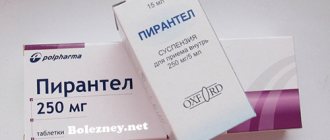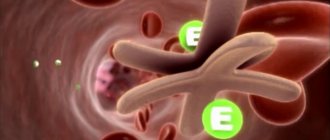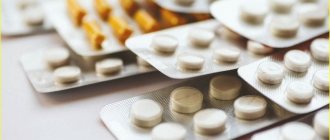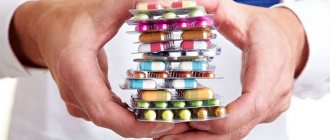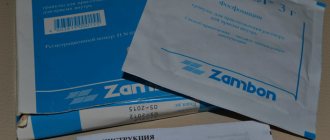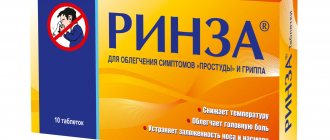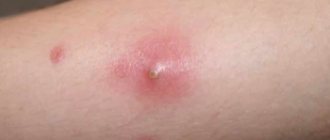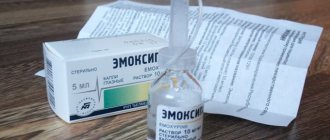Bacterial infection is the most common cause of inflammation of the bladder lining (cystitis). The basis of treatment for bacterial cystitis, as well as other infectious diseases of the urinary tract, is therapy with antimicrobial drugs (AMP).
The antimicrobial drug Nolitsin for cystitis is considered one of the most effective and safe; it quickly improves the condition of patients and promotes the eradication of bacteria.
Read more about Nolicin and instructions for its use for cystitis in this article.
Medicinal action
The active substance Nolitsin suppresses the DNA of the bacterial cell, that is, it is a bacteriostatic. Norfloxacin acts in 3 directions:
- suppression of genetic information in a bacterial cell;
- preventing the formation of an integral helix from nucleotides;
- division of DNA into smaller fragments.
The antibiotic Nolitsin is active against the vast majority of representatives of opportunistic and pathogenic flora. Cases of development of resistance to norfloxacin are extremely rare. No cross-resistance with antibiotics from other groups was detected.
The drug Nolicin is active against the following bacterial agents:
- Gram-negative aerobes - Proteus, Salmonella, Shigella, Providencia, Enterobacteriaceae, Escherichia coli, various strains of Klebsiella.
- Gram-positive aerobes - enterococci, various strains of staphylococcus, streptococcus.
- The drug is active against protozoan microorganisms, such as ureaplasma, mycoplasma.
Norfloxacin is rapidly absorbed and its maximum amount in the tissues of the urogenital tract and urinary system is observed 3 hours after administration. It is excreted in feces, up to 30% unchanged in urine.
Pharmacokinetics
Suction
Norfloxacin after oral administration from the gastrointestinal tract is absorbed quite quickly, but not in full (20-40%). Cmax is fixed after an hour or two and is observed from 0.8 to 2.4 μg/ml, depending on the dose. Absorption of the drug slows down food intake.
Distribution and metabolism
The binding of norfloxacin to plasma proteins is quite low (10-15%), high solubility directly in lipids determines the large Vd of the drug and good penetration into tissues and organs (ovaries, uterus, kidney parenchyma, prostate gland, seminiferous tubule fluid, pelvic and abdominal organs). cavities, breast milk, bile).
Penetrates the placental barrier and the BBB. Metabolized to a small extent in the liver.
Removal
T1/2-3-4 hours. Excreted from the body through the kidneys, by tubular secretion and glomerular filtration. From the moment of administration, within 24 hours, 32% of the dose is excreted unchanged through the kidneys, in the form of metabolites - 5-8%, about 30% of the dose taken - with bile.
Use for cystitis and pyelonephritis
The drug is used for diseases of the urogenital tract and urinary system in acute and chronic form.
Nolicin is the drug of choice for the following diagnoses:
- cystitis;
- inflammation of the renal pelvis;
- pyelonephritis;
- prostatitis;
- neurogenic cystitis;
- inflammation caused by the presence of stones in the kidney.
The main cause of inflammatory processes in the bladder is damage to its inner lining by E. coli. It is capable of developing resistance to norfloxacin. Therefore, in case of cystitis, it is recommended to conduct a urine test to identify the causative agent of the disease and its resistance to antibiotics of various groups.
How to take Nolitsin for cystitis, pyelonephritis depends on the severity of the inflammatory process, its form (acute or chronic), the age of the patient and the presence of other diseases of various organs and systems.
Diseases for which medicine is prescribed
Many people believe that Nolitsin is an antibiotic for cystitis. That’s right: this is one of the most prescribed drugs for chronic and acute inflammation of the bladder. But its scope of application is not limited to one disease. The following pathologies are treated today with the help of medicine:
- gastroenteritis of bacterial origin - shigellosis, salmonellosis, dysentery;
- infectious diseases of the genital organs - endometritis, cervicitis;
- uncomplicated gonorrhea;
- chronic inflammation of the prostate caused by bacteria;
- pyelonephritis;
- inflammation of the urethra.
The drug is used not only for medicinal but also for preventive purposes. It is prescribed to prevent recurrence of urinary tract infections, septic complications in patients with neutropenia, and travelers' diarrhea.
In what cases is Nolitsin contraindicated?
The medicine for cystitis Nolitsin has a small number of contraindications. It is prohibited to prescribe fluoroquinolone for the following categories of patients:
- history of hypersensitivity to norfloxacin and other fluoroquinolones;
- history of tendonitis, ruptures or tendon injuries for which quinolone derivatives were used;
- gestational period;
- lactation.
Nolicin tablets for cystitis are not used in pediatric practice. Therefore, the medication is not prescribed until the age of 18.
Contraindications to taking Nolitsin
Despite the wide spectrum of action of the drug, its use is prohibited in the following cases:
Anti-worm suppositories for children and adults
- Individual sensitivity or intolerance to norfloxacin and/or other components of the drug;
- Intolerance to acetylsalicylic acid;
- Circulatory disorders in the brain;
- History of epileptic seizures;
- Liver and kidney failure;
- Atherosclerosis;
- Children under 18 years of age;
- Glucose-6-phosphate dehydrogenase deficiency;
- Malignant myasthenia (with caution).
Important: the drug Nolitsin is prescribed very carefully for arrhythmia, hypokalemia, and barycardia. It is also worth prescribing Nolitsin very carefully if the patient is receiving therapy with tricyclic antidepressants,
antipsychotic drugs or cisapride.
Adverse reactions
The drug has a wide range of side effects. The most significant of them is the stimulating effect on the central nervous system. This is manifested by increased anxiety and insomnia, and mental disorders.
Other common adverse reactions of Nolitsin for cystitis in women:
- arrhythmia;
- nausea;
- gastrointestinal disorder;
- headache;
- mental disorders;
- epileptic seizures;
- euphoria and disorientation in space;
- panic attacks;
- hallucination;
- tinnitus;
- depressive states;
- inflammatory processes in the musculoskeletal system, arthralgia;
- change in blood formula;
- allergic manifestations - rash, itching, development of a state of shock;
- enterocolitis;
- heartburn;
- trembling of limbs;
- neuropathy;
- inflammatory processes in the pancreas;
- oxalates in urine;
- bleeding from the urethra;
- decreased or hyperproduction of urine;
- infection by fungi of the genus Candida;
- hearing loss;
- hepatitis, obstructive jaundice.
If any unpleasant symptoms appear, treatment should be stopped and consult a doctor to adjust the dosage or completely discontinue the drug.
If severe reactions develop, hospitalization of the patient is indicated. Treatment in this case is carried out with antihistamines, corticosteroids, and, if necessary, connection to a ventilator.
We didn't wait! Possible side effects
When taking Nolicin, the following unpleasant phenomena may occur:
- nausea and vomiting;
- bitter taste;
- stomach ache;
- decreased appetite;
- loose stool;
- increased blood creatinine;
- glomerulonephritis;
- the appearance of salt crystals in urine;
- bleeding and urination;
- an increase in the volume of urine produced;
- difficulty urinating;
- specific dysbacteriosis, which causes inflammatory damage to the intestines;
- increased concentration of protein in urine;
- increase in AST and ALT enzymes;
- headache;
- hallucinations;
- itching;
- heart rhythm disturbance;
- fainting, sleep disturbance, swelling;
- exudative erythema;
- photophobia;
- thrush;
- pain in the joints.
Interaction with other drugs
Nolicin should not be prescribed simultaneously with nitrofurantoin. These are antagonist drugs. Co-administration with theophylline increases the side effects of norfloxacin.
During treatment, it is undesirable to consume coffee or caffeine-containing drugs, since the active component Nolitsin increases the half-life of caffeine.
The drug enhances the effect of Warfarin and other anticoagulants. Nolicin reduces the activity of anticonvulsants, therefore it should be prescribed to patients with epilepsy only if other antibacterial agents are ineffective.
The effectiveness of hormonal contraceptives, according to studies, does not decrease during treatment with the antibiotic Nolitsin. Despite this, the instructions for use of the drug recommend the use of barrier methods of protection during treatment.
It is prohibited to prescribe norfloxacin during therapy with centrally acting muscle relaxants, in particular with Tizanidine. The same rule applies to sulfonylurea drugs. Simultaneous use may provoke severe forms of hypoglycemia.
It is undesirable to take NSAID drugs during treatment with Nolitsin due to the risk of developing convulsions and seizures.
Vitamins containing calcium and multicomponent mineral complexes should be taken 4 hours before fluoroquinolone or 4 hours after it. Calcium forms an insoluble compound with norfloxacin and the effectiveness of treatment is reduced.
How should I take the medicine?
For the treatment of uncomplicated forms of cystitis, take four hundred milligrams twice a day, for a course of three to five days. In case of acute urinary tract infections, this drug is consumed half a gram every twelve hours. The duration of treatment is from seven to ten days.
The instructions for use of Nolitsin contain information that against the background of chronic and often recurrent urinary tract infections, the duration of taking the drug can be up to twelve weeks. In this case, in the first month the drug is taken four hundred milligrams every twelve hours, and then one tablet per day.
For the treatment of acute as well as uncomplicated types of gonorrhea, a single dose of two or three Nolicin tablets is recommended. Price, reviews, analogues are presented below. In addition, if necessary, the medicine can be taken one tablet twice a day and continue the course for up to one week.
Against the background of infectious inflammation of the reproductive system, it is recommended to consume from 400 to 500 milligrams every twelve hours for a week. For patients with bacterial gastroenteritis, it is advisable to use the product for five days, half a gram twice a day.
In order to prevent diarrhea, travelers take one tablet of Nolitsin before departure, and then continue the course of one tablet a day until the end of the trip. The total duration of taking this antibiotic should not exceed 3 weeks.
"Nolitsin" is also prescribed to patients with neutropenic conditions, when the goal is to prevent the development of septic complications. In such a situation, doctors prescribe this antibiotic 800 milligrams per day, divided into two doses. The course lasts up to eight weeks. Reviews of Nolitsin for cystitis are also presented.
To prevent exacerbation of urinary tract infection, the drug is prescribed at a dose of 200 milligrams once a day. The duration of treatment in this case is set by the attending physician and directly depends on the frequency of relapses. If necessary, the duration of taking an antibiotic can be up to six months. Adjustment of the prescribed dose in persons with kidney disease is carried out depending on the clearance of creatinine in the body.
Alcohol compatibility
Alcoholic beverages are not compatible with fluoroquinolones, including norfloxacin. The active component of Nolitsin has an effect on the central nervous system, which is derived as a side effect of the drug.
While taking norfloxacin, both inhibition and excitation of brain neurons are possible. Ethanol works in a similar way. When taken together, ethyl alcohol and norfloxacin can potentiate (strengthen) each other's effects. This, in turn, can result in severe intoxication and the development of coma.
Alcohol increases diuresis and irritates the urinary system. Drinking alcohol is prohibited in case of cystitis, pyelonephritis, and other kidney diseases.
Release form, composition and packaging
The drug Nolitsin is produced:
In the form of tablets, slightly biconvex, round, covered with an orange film coating on top, on one side there is a mark.
Active ingredients: 1 tablet contains 400 mg of norfloxacin.
Additional components: sodium carboxymethyl starch, microcrystalline cellulose, magnesium stearate, povidone, purified water (for hydration), anhydrous colloidal silicon dioxide.
Shell composition: propylene glycol, titanium dioxide, talc, hypromellose, (E110) sunset yellow dye (E110 - dispersed yellow dye).
A cardboard pack contains 1 blister with 10 tablets.
There are 2 blisters in a cardboard pack, each with 10 tablets.
Recommendations during use
Cystitis in patients taking anticonvulsants should be treated in a medical facility. Fluoroquinolones reduce the activity of antiepileptic drugs, so an attack may develop during therapy.
Milk, fermented milk products, and artificial nutritional formulas work similarly to antacids. Therefore, you should take the tablets strictly on an empty stomach, and wash them down with clean water.
During treatment with norfloxacin, increased sensitivity to ultraviolet radiation is possible. Therefore, it is undesirable to stay outside for a long time; sunbathing and visiting a solarium are prohibited.
When the first signs of muscle or joint pain appear during treatment with the drug, it should be discontinued immediately. The doctor then decides how to take Nolitsin for arthralgia or developed tendonitis.
special instructions
The drug is prescribed with caution to patients with epilepsy, a history of seizures, and severe renal dysfunction. During treatment with the drug, patients should receive a sufficient amount of fluid (under the control of diuresis). During therapy with Nolicin, an increase in the prothrombin index was noted. When performing surgical interventions, the state of the blood coagulation system should be monitored. During treatment with Nolicin, exposure to direct sunlight should be avoided. If pain appears in the tendons or at the first signs of tenosynovitis, it is recommended to discontinue the drug. Persistent diarrhea may be due to the development of pseudomembranous colitis, although this is rarely associated with norfloxacin therapy. Patients should avoid increased physical activity during treatment and immediately after completion of treatment. When using Nolitsin simultaneously with theophylline and cyclosporine, it is recommended to monitor plasma concentrations of the latter. Antacids, sucralfate, iron or zinc preparations should be taken 2 hours after taking Nolicin. Milk and yogurt reduce the absorption of norfloxacin, so the drug should be taken 1 hour before or 2 hours after a meal containing milk or yogurt. Use in pediatrics The drug should not be prescribed to children and adolescents, since there is no experience with the use of Nolicin in this category of patients and the possibility of damage to articular cartilage during growth cannot be completely excluded. Effect on the ability to drive vehicles and operate machinery Due to the possible occurrence of dizziness, patients taking Nolitsin should be careful when driving a car and engaging in other potentially hazardous activities that require increased attention and speed of psychomotor reactions (especially when consuming alcohol at the same time).
Information about "Nolitsin"
Women wonder: is Nolitsin an antibiotic? To answer, let’s look at the characteristics of the drug.
The active ingredient is norfloxacin. According to the classification of antibacterial drugs, it belongs to the group of fluoroquinolones.
Nolitsin tablets are taken to eliminate the symptoms of cystitis. The therapeutic effect develops due to the active influence on the cause of inflammation.
As you know, cystitis is a pathology that occurs when infectious agents enter the sterile environment of a bladder. Therefore, therapy is aimed at destroying microbes.
The drug copes:
- Staphylococci, streptococci, enterococci.
- Escherichia coli and Pseudomonas aeruginosa.
- Causative agents of gonorrhea, salmonella, shigella, hemophilus influenzae.
"Nolicin" is only bactericidal. There is complete inhibition and death of microorganisms that caused the disease.
The mechanism is associated with inhibition of enzymes in the bacterial cell. Destabilization of DNA molecules develops, which leads to lysis of microbes.
"Nolitsin" for cystitis is effective for 12 hours. After this time, a new tablet is taken to maintain the antimicrobial effect.
"Nolitsin" is an antibiotic. The drug belongs to a group that has pronounced therapeutic activity and eliminates pathogenic infections.
An antibacterial agent is a compound that causes inhibition or death of microbes. Considering the characteristics of the drug, it is considered a 100% antibiotic.
Nolicin during early pregnancy
Of course, discussions among doctors on this matter still arise. For example, some experts are confident that the use of such a serious substance at the beginning of gestation will bring nothing but harm to the embryo. Others believe that the presence of an infectious-inflammatory focus in the mother’s body poses a much greater danger to the fetus, so Nolitsin is necessary in any case. What then should the pregnant woman do?
Each case of illness has its own nuances. If the infection behaves so aggressively that the doctor does not see any other method of treatment other than antibacterial therapy, then the use of Nolicin is completely justified. To monitor the condition of the fetus, you can always undergo an additional ultrasound. Even if the gynecologist does not see an urgent need for the first or second screening, the expectant mother should insist on this procedure.
Compound
The active ingredient is norfloxacin. 1 tablet contains 400 mg of the component. A number of excipients have been added:
- povidone:
- MCC;
- magnesium stearate, etc.
Povidone, MCC and magnesium stearate in combination act on pathogens, blocking their reproduction.
Nolicin during pregnancy: side effects
Treatment with Nolicin can present an unpleasant surprise in the form of side effects, so the expectant mother should carefully monitor her well-being during this period. Symptoms may include:
- the digestive system most often reacts to the action of Nolitsin with abdominal pain, nausea, dry mouth, vomiting, and occasionally diarrhea;
- side effects from the nervous system include frequent headaches, insomnia, dizziness and hallucinations;
- if somehow the cardiovascular system was affected due to treatment with Nolitsin, the malaise will consist of a decrease in blood pressure and a change in heart rate;
- polyuria, dysuria - side effects from the urinary system;
- if a person is prone to allergic reactions, he may experience itching and rash on the skin, sometimes Quincke's edema develops;
- there is a violation of the functionality of the musculoskeletal system in the form of joint inflammation and pain;
- candidiasis of the mucous membranes.
Antibiotic or not
Nolitsin is often classified as an antibacterial agent. Yes, if you read the instructions and description of the medicine, as well as the purposes of use, it is considered an antibiotic. But Nolitsin is an antibiotic or not. This drug works thanks to the main substance – nofloxacin from the group of fluoroquinolones. These components are distinguished by their effectiveness in combating microbes. This means that they are used as a basis for broad-spectrum antibacterial agents. This fact raises many questions about Nolitsna - an antibiotic or not. The medicine is very similar to antibiotics, but at the same time, Nolitsin has a different chemical structure and has no natural analogues. These arguments do not make it possible to completely classify the drug as an antibacterial agent.
Nolitsin is not inferior in strength to antibiotics, so it should be taken after a doctor’s prescription. A group of broad-spectrum medications indicates that the drug can resist any pathogen.
Before the appointment, a test is carried out and only then will it be possible to guarantee the presence or absence of positive results in treatment from Nolitsin.
Nolicin® analogues
As cheaper analogues of Nolitsin® containing norfloxacin, the following can be used:
- Loxona-400®;
- Normaxa®;
- Norbactin®;
- Norfloxacin® (Vertek®, Russia);
- Norfloxacin® (Obolenskoye FP®, Russia).
Nolicin® or Monural®, which is better?
It is impossible to say for sure which drug is better. Before choosing an agent for the treatment of cystitis, many factors should be taken into account, such as the patient’s age, the presence of various contraindications, pregnancy, relapse rate, sensitivity of the pathogen, severity of the disease and the presence of complications.
The drug of choice for the treatment of uncomplicated cystitis is Monural®. This drug is unique in its kind, since the course of treatment is one to two days. Monural is well tolerated by patients and causes virtually no side effects during and after treatment.
Monural® can also be used to treat children over five years of age and pregnant women.
The advantage of Nolicin® is that it can be used in long courses to prevent exacerbations.
Nolicin during pregnancy: what is the risk
The fetus is most vulnerable at the very beginning of pregnancy, when the formation of vital organs is just beginning. In this regard, doctors prefer not to prescribe Nolicin to pregnant women in the 1st trimester. Such a need may arise only in isolated, exceptional cases.
Women are especially worried if they took Nolitsin without knowing about their pregnancy. Then the unfortunate people torment themselves with the question: will this affect the health of the unborn child? Previously, in such a situation, an abortion could be advised, but today doctors are not so categorical. Firstly, Nolicin does not have a mutagenic effect. Secondly, if the fertilized egg is subjected to a strong negative impact, as a rule, at 5 - 8 weeks the pregnancy is terminated on its own. If the embryo continues to develop, then the risk of developing any abnormalities due to Nolitsin is quite low.
The capabilities of modern diagnostic medicine make it possible to notice gross anomalies in the development of a child in the early stages. After treatment with an antibacterial drug, it is important not to skip an ultrasound (3 - 4 procedures per pregnancy) and do a triple test between 16 and 20 weeks of pregnancy.
Reviews
A worthy and effective drug of its group. It has repeatedly proven its effectiveness in use for urological infections. And today it remains quite effective and is not much inferior to its classmates. The price/quality ratio is good. Tolerability is satisfactory. I rarely encountered side effects.
Maryasov A. S., Surgeon, https://protabletky.ru/nolicin/#otzivi
I encountered cystitis about six years ago. For me it was horror; for those not familiar with this disease, let me explain. Cystitis manifests itself in frequent and painful urination, it came to tears. Until my mother gave me Nolitsin, or rather, they brought it straight to my work, because I couldn’t even get to the pharmacy) The problem generally requires seeing a doctor! From then until every spring and autumn, cystitis haunts me. Nolitsin always helps out, at an advanced stage, when the pain is already noticeable, relief occurs on the second day of taking the pills. If the symptoms are just beginning, and you start taking it immediately, the disease will not go into an unpleasant phase. Ideally, you need to take the course as written in the instructions. Nolitsin tablets have always helped me, I wanted to try others, but I don’t dare yet.
Monalisa, https://otzovik.com/review_1496040.html
Pharmacological properties
Numerous medical studies have proven the high therapeutic effectiveness of the drug. The main effect is antibacterial and bactericidal. Nolicin belongs to the quinolone class of anti-infective drugs.
It is directed against bacteria that cause various infections in the human body. The active substance it contains destroys the DNA chain in the microorganism. This process leads to the death of pathogenic microbes.
Nolitsin: instructions
The drug Nolitsin according to its pharmacological action is included in the category of antibacterial drugs belonging to the group of fluoroquinolones.
Shows a wide spectrum of action, which applies to staphylococci, gonococci, salmonella, chlamydia, mycoplasma, klebsiella, Vibrio cholerae, Escherichia coli, Vibrio cholerae, but not to streptococci and anaerobic bacteria.
The active component of Nolicin is norfloxacin, which causes the death of bacterial cells by disrupting the stability of the DNA molecule.
The antimicrobial effect of norfloxacin lasts over 10 hours. After entering the body, the drug enters the bloodstream, and then accumulates in tissue structures and organs.
Taking the drug with food affects its absorption in the body, slowing it down.
The recommended use of the drug is on an empty stomach, one hour before meals, or after meals, 2 hours later; inside with water. There must be enough water.
There is an interaction between Nolitsin and other drugs when used together, which can result in either an increase or decrease in the therapeutic effect.
Side effects of Nolicin:
- Digestive organs - manifested in the form of decreased appetite, nausea and vomiting, pain in the abdomen, bitter taste in the mouth
- Nervous system – expressed in the form of headaches and dizziness, fainting, hallucinations, sleep disturbances; in older patients, panic, restlessness, anxiety, and depressive states worsen
- Heart and blood vessels - manifest themselves in the form of heart rhythm disturbances (arrhythmia, tachycardia), low blood pressure, vasculitis
- Musculoskeletal system – arthralgia, tendons, damage, even ruptures, to tendons may occur
- Hematopoiesis – can cause eosinophilia, leukopenia, affect hemotocrit, lowering it
Additional side effects of Nolitsin are expressed in the manifestation of allergic reactions in the form of rashes, including those accompanied by itching; swelling, urticaria.
Taking the drug may cause candidiasis.
When a doctor prescribes Nolitsin, you should thoroughly study the instructions for use, paying special attention to the list of side effects of the drug.
Contraindications and complications
Nolicin for cystitis in women (patient reviews indicate this) has a rapid effect.
The drug is also prescribed for inflammation:
- bacterial prostatitis;
- gonococcal infection;
- nonspecific epididymitis;
- pyelonephritis;
- bacterial gastroenteritis;
- sepsis;
- infectious diarrhea;
- uncomplicated gonorrhea;
- shigellosis;
- endometritis;
- cervicitis.
Nolitsin is used for infectious diseases in people with weakened immune systems. For ENT diseases, in ophthalmology it is used topically, for which drugs in the form of drops are used.
The drug is not recommended for use:
- children who have not reached 18 years of age;
- pregnant women (recommended for absolute indications, when the effectiveness for the woman’s health exceeds the risk for the child);
- patients hypersensitive to the components of the drug or its active substance;
- people with deficiency of the enzyme G6PD (glucose-6-phosphate dehyde progenase).
The medicine is prescribed very carefully to patients with pathologies:
- brain vessels;
- liver, kidneys;
- epileptic seizures;
- impaired blood flow in the brain.
As is the case with other strong antibiotics (and the question “is nolicin an antibiotic or not?” is not even discussed - of course yes), the instructions for use contain more information about contraindications and risks than about the beneficial effects of the drug. Unfortunately, defeating an infection that has settled in the human body is much more difficult than allowing it to penetrate there.
So, in what cases is nolicin not taken or taken with caution?
Absolute contraindications:
- Age up to 18 (in some sources – up to 15) years.
- Pregnancy, since the drug easily crosses the placental barrier.
- Breastfeeding - nolicin accumulates in milk.
- Individual intolerance to fluoroquinolones.
- Congenital deficiency of the enzyme glucose-6-phosphate dehydrogenase, which is responsible for supplying cells with oxygen. When combined with fluoroquinolones, G6PD deficiency leads to severe anemia
- Epilepsy.
- Atherosclerosis of cerebral vessels.
- Liver and kidney failure.
Nolicin in combination with general anesthesia can lead to a sharp decrease in blood pressure. If the patient is undergoing surgery not related to an infectious disease, he should inform the surgeons that he is taking nolicin.
In addition, before starting therapy, it is imperative to do a bacterial culture of urine, feces or genital smear to determine the causative agent of the infection. If it turns out to be a microorganism that is immune or insensitive to the action of nolitsin, you need to look for another antibiotic.
Self-medication with the drug is strictly unacceptable - in this way you can cause severe dysbiosis and poisoning without getting rid of the underlying disease or transforming it into an intractable chronic form.
The duration of treatment is determined by the doctor strictly individually and can be adjusted over time. In case of mild acute cystitis, a short course can be prescribed in the form of 2 tablets of 400 mg per day for 3 days. With this course, the toxicity of nolitsin is practically not felt.
In more severe cases, the drug is taken for 1-2 weeks at the same dosage. In no case should you increase it - this will not give any effect, but the side effects may worsen.
https://www.youtube.com/watch?v=z_JHuRJCDgo
For pyelonephritis, nolitsin is taken for 2 to 6 weeks. Control urine tests are taken every 3 days.
For exacerbation of chronic inflammation of the urinary tract (including chronic cystitis), one tablet per day is usually prescribed, but this depends on the clinical picture and the patient’s body weight. Women and men are usually prescribed the same dosage.
Side effects
Complications when taking nolitsin and other fluoroquinolones can affect various organs and systems. The most common:
- disorders of the gastrointestinal tract (nausea, vomiting, diarrhea, taste of bile in the mouth, loss of appetite);
- pathologies of the urinary system - inflammation of the kidney tissue, excessive urine output (polyuria), pain and the appearance of blood when urinating, excretion of protein and salts in the urine, increased creatinine levels in the blood;
- arrhythmia, increased heart rate, decreased blood pressure, vasculitis (inflammation of the walls of blood vessels);
- headache, tinnitus, irritability, depression, fatigue, insomnia, dizziness, fainting;
- a decrease in the total number of leukocytes with a simultaneous increase in the level of eosinophils - leukocytes responsible for the manifestation of allergic reactions;
- urticaria, skin itching, other manifestations of allergies up to Stevens-Johnson syndrome (extremely rare);
- exacerbation of fungal infections (candidiasis, chlamydia, etc.).
Nolitsin has a non-lethal, but very unpleasant side effect on the tissues of joints and tendons. They lose elasticity, become inflamed, hurt and tear at every opportunity. Sprains and ruptures of ligaments are a painful and difficult-to-heal injury, therefore sports and heavy physical labor are contraindicated during treatment with nolitsin. Driving vehicles and complex machinery is also not recommended, as the drug reduces concentration.
Like any strong antibiotic, nolicin is incompatible with alcohol. At best, the patient will experience constant weakness and decreased ability to work; at worst, severe allergic reactions up to Stevens-Johnson syndrome and anaphylactic shock.
Dairy products and heartburn medications worsen the absorption of the antibiotic.
The drug should not be taken together with antidiabetic agents based on sulfonylureas, theophylline, or nitrofurans.
Conclusion
Nolitsin is a highly effective, but very toxic antibiotic for the treatment of bacterial infections of the urinary tract and reproductive organs of men and women, including acute and chronic cystitis. It is prescribed in cases where therapy with less dangerous drugs is considered insufficiently effective.
As expected, there are both negative and positive reviews about nolicine on the Internet. The former are associated with inevitable side effects, the latter – with the high effectiveness of treatment and the affordable price of the drug. A package of 10 tablets costs 120-150 rubles in pharmacies, a package of 20 tablets costs 200-270 rubles.
